Islam: Masjid (Mosque's)
Masjid (Mosque's)

A mosque is a place of worship for followers of the Islamic faith. Muslims often refer to the mosque by its Arabic name, masjid ( Arabic: مسجد — ).
Quote:
|
The word "mosque" in English refers to all types of buildings dedicated for Islamic worship, although there is a distinction in Arabic between the smaller, privately owned mosque and the larger, "collective" mosque (masjid jami) (Arabic: جامع ), which has more community and social amenities.
|
The primary purpose of the mosque is to serve as a place where Muslims can come together for prayer. Nevertheless, mosques are known around the world nowadays for their general importance to the Muslim community as well as their demonstration of Islamic architecture. They have developed significantly from the open-air spaces that were the Quba Mosque and Masjid al-Nabawi in the seventh century.
 Today, most mosques have elaborate domes, minarets, and prayer halls. Mosques originated on the Arabian Peninsula, but now exist on all the world's inhabited continents. They are not only places for worship and prayer, but also places to learn about Islam and meet fellow believers. Today, most mosques have elaborate domes, minarets, and prayer halls. Mosques originated on the Arabian Peninsula, but now exist on all the world's inhabited continents. They are not only places for worship and prayer, but also places to learn about Islam and meet fellow believers.
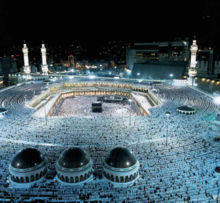
(Picture above, click to enlarge - The Masjid al-Haram in Mecca as it exists today )
 Etymology Etymology
The Arabic word masjid means place of worship and is a noun of place from the verb sajada (root "s-j-d," meaning "to bow" or "to kneel") in reference to the prostrations performed during Islamic prayers. Either the word masjid itself or at least the verb from which it is derived was borrowed from Aramaic. The word "m-s-g-d" is attested in Aramaic as early as the 5th century BCE, and the same word is later found in Nabataean inscriptions with the meaning "place of worship"; apparently, this Aramaic word originally meant "stele" or "sacred pillar".
 The modern-day English word "mosque", just like its equivalents in many other European languages, derives from the word masjid via Spanish mezquita.The pre-cursors of the word "mosque" appeared during the 15th, 16th, and 17th centuries and "Moseak", "muskey", "moschy", and "mos'keh" were just some of the variations that came into use until it was decided that "mosquee", imitating Middle French, Italian, and Old Spanish, would become the standard. In the early 18th century, the modern spelling became the most popular and standard spelling of the word. The modern-day English word "mosque", just like its equivalents in many other European languages, derives from the word masjid via Spanish mezquita.The pre-cursors of the word "mosque" appeared during the 15th, 16th, and 17th centuries and "Moseak", "muskey", "moschy", and "mos'keh" were just some of the variations that came into use until it was decided that "mosquee", imitating Middle French, Italian, and Old Spanish, would become the standard. In the early 18th century, the modern spelling became the most popular and standard spelling of the word.
 Mosque in Islamic texts Mosque in Islamic texts
The word "masjid" is found throughout the Qur'an, most frequently with the reference to the sanctuary of Kaaba in the city of Mecca. The Qur'an applies the term "masjid" to places of worship of different religions, including Judaism and Christianity; in the same general meaning of a place of worship, the word is used in the hadith, collections of Muslim traditions about the deeds and saying of their prophet Muhammad and his companions.
 History History
Grand entryways and tall towers, or minarets, have long been and continue to be closely associated with mosques. However, the first three mosques were very simple open spaces on the Arabian Peninsula. Mosques evolved significantly over the next 1,000 years, acquiring their now-distinctive features and adapting to cultures around the world.
 The first mosques The first mosques
According to Islamic beliefs, the first mosque in the world was the Kaaba, which was built by Abraham upon an order from God. The oldest Islamic-built mosque is the Quba Mosque in Medina. When Muhammad lived in Mecca, he viewed Kaaba as his first and principal mosque and performed prayers there together with his followers.
 Even during times when the pagan Arabs performed their rituals inside the Kaaba, Muhammad always held the Kaaba in very high esteem. The Meccan tribe of Quraish, which was responsible for guarding Kaaba, attempted to exclude Muhammad's followers from the sanctuary, which became a subject of Muslim complaints recorded in the Qur'an. Even during times when the pagan Arabs performed their rituals inside the Kaaba, Muhammad always held the Kaaba in very high esteem. The Meccan tribe of Quraish, which was responsible for guarding Kaaba, attempted to exclude Muhammad's followers from the sanctuary, which became a subject of Muslim complaints recorded in the Qur'an.
 When Muhammad conquered Mecca in 630, he converted Kaaba to a mosque, which has since become known as the Masjid al-Haram, or Sacred Mosque. The Masjid al-Haram was significantly expanded and improved in the early centuries of Islam in order to accommodate the increasing number of Muslims who either lived in the area or made the annual Hajj, or pilgrimage, to Mecca, before it acquired its present shape in 1577 in the reign of the Ottoman sultan Selim II. When Muhammad conquered Mecca in 630, he converted Kaaba to a mosque, which has since become known as the Masjid al-Haram, or Sacred Mosque. The Masjid al-Haram was significantly expanded and improved in the early centuries of Islam in order to accommodate the increasing number of Muslims who either lived in the area or made the annual Hajj, or pilgrimage, to Mecca, before it acquired its present shape in 1577 in the reign of the Ottoman sultan Selim II.
 The first thing Muhammad did upon arriving with his followers near Medina (then named Yathrib) after the emigration from Mecca in 622 was build the Quba Mosque in a village outside Medina.[4] Muslims believe he stayed at the Quba Mosque for three days before moving on to Medina. The first thing Muhammad did upon arriving with his followers near Medina (then named Yathrib) after the emigration from Mecca in 622 was build the Quba Mosque in a village outside Medina.[4] Muslims believe he stayed at the Quba Mosque for three days before moving on to Medina.
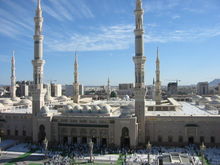
(The Masjid al-Nabawi in Medina as it exists today)
 Just days after beginning work on the Quba Mosque, Muhammad went on to establish another mosque in Medina, known today as the Masjid al-Nabawi, or the Prophet's Mosque. The location of the mosque was declared as such after it hosted Muhammad's first Friday prayer. Following its establishment, the Masjid al-Nabawi continued to introduce some of the practices now considered common in today's mosques. For example, the adhan, or call to prayer, was developed in the form still used in mosques today. Just days after beginning work on the Quba Mosque, Muhammad went on to establish another mosque in Medina, known today as the Masjid al-Nabawi, or the Prophet's Mosque. The location of the mosque was declared as such after it hosted Muhammad's first Friday prayer. Following its establishment, the Masjid al-Nabawi continued to introduce some of the practices now considered common in today's mosques. For example, the adhan, or call to prayer, was developed in the form still used in mosques today.
 The Masjid al-Nabawi was built with a large courtyard, a motif common among mosques built since then. Muhammad would stand up at one end of the arcade to preach. Later on, he would develop a three-step pulpit as a platform from which he would give sermons. The pulpit, now known as a minbar, is still a common feature of mosques. The Masjid al-Nabawi was built with a large courtyard, a motif common among mosques built since then. Muhammad would stand up at one end of the arcade to preach. Later on, he would develop a three-step pulpit as a platform from which he would give sermons. The pulpit, now known as a minbar, is still a common feature of mosques.
 Muhammad lived beside the mosque in Medina, which doubled as both a religious and political center for the early Muslim community. Negotiations were conducted, military actions planned, prisoners of war held, disputes settled, religious information disseminated, gifts received and distributed among his companions. His followers treated the wounded there and some people even lived in the mosque permanently in tents and huts. Muhammad lived beside the mosque in Medina, which doubled as both a religious and political center for the early Muslim community. Negotiations were conducted, military actions planned, prisoners of war held, disputes settled, religious information disseminated, gifts received and distributed among his companions. His followers treated the wounded there and some people even lived in the mosque permanently in tents and huts.
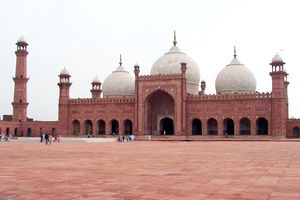
(The Badshahi Masjid in Lahore, Pakistan with an iwan at center, three domes, and five visible minarets)
 Today, the Masjid al-Haram in Mecca, the Masjid al-Nabawi in Medina and Al Aqsa in Jerusalem are considered the three holiest sites in Islam. Today, the Masjid al-Haram in Mecca, the Masjid al-Nabawi in Medina and Al Aqsa in Jerusalem are considered the three holiest sites in Islam.
 Diffusion and evolution Diffusion and evolution
Mosques were built outside the Arabian Peninsula as Muslims moved to other parts of the world. Egypt became occupied by Muslim Arabs as early as 640, and since then so many mosques have appeared throughout the country that its capital city, Cairo, has acquired the nickname of city of a thousand minarets.[
 Egyptian mosques vary in amenities, as some have Islamic schools (madrassas) while others have hospitals or tombs. Mosques in Sicily and Spain do not reflect the architecture of Visigoth predecessors, but instead reflect the architecture introduced by the Muslim Moors. Egyptian mosques vary in amenities, as some have Islamic schools (madrassas) while others have hospitals or tombs. Mosques in Sicily and Spain do not reflect the architecture of Visigoth predecessors, but instead reflect the architecture introduced by the Muslim Moors.
 The first Chinese mosque was established in the eighth century in Xi'an. The Great Mosque of Xi'an, whose current building dates from the eighteenth century, does not replicate many of the features often associated with traditional mosques. The first Chinese mosque was established in the eighth century in Xi'an. The Great Mosque of Xi'an, whose current building dates from the eighteenth century, does not replicate many of the features often associated with traditional mosques.

Instead, it follows traditional Chinese architecture. Mosques in western China incorporate more of the elements seen in mosques in other parts of the world. Western Chinese mosques were more likely to incorporate minarets and domes while eastern Chinese mosques were more likely to look like pagodas.
 Mosques diffused into India during the reign of the Mughal empire in the sixteenth and seventeenth centuries. The Mughals brought their own form of architecture that included pointed, onion-shaped domes, as seen in Delhi's Jama Masjid. Mosques diffused into India during the reign of the Mughal empire in the sixteenth and seventeenth centuries. The Mughals brought their own form of architecture that included pointed, onion-shaped domes, as seen in Delhi's Jama Masjid.
 Mosques first arrived in the Ottoman Empire (mostly present-day Turkey) during the eleventh century, when many of the Turks in the region began to convert to Islam. Several of the first mosques in the Ottoman Empire, such as the Hagia Sophia in present-day Istanbul, were originally churches or cathedrals in the Byzantine Empire. Mosques first arrived in the Ottoman Empire (mostly present-day Turkey) during the eleventh century, when many of the Turks in the region began to convert to Islam. Several of the first mosques in the Ottoman Empire, such as the Hagia Sophia in present-day Istanbul, were originally churches or cathedrals in the Byzantine Empire.

(Click to enlarge - The Sultan Ahmed Mosque / Blue Mosque in Istanbul, Turkey with its tall, slender minarets is considered a classic example of Ottoman architecture )
 The Ottomans created their own design of mosques, which included large central domes, multiple minarets, and open façades. The Ottoman style of mosques usually included elaborate columns, aisles, and high ceilings in the interior, while incorporating traditional elements, such as the mihrab.[ The Ottomans created their own design of mosques, which included large central domes, multiple minarets, and open façades. The Ottoman style of mosques usually included elaborate columns, aisles, and high ceilings in the interior, while incorporating traditional elements, such as the mihrab.[
Today, Turkey is still home to many mosques that display this Ottoman style of architecture.
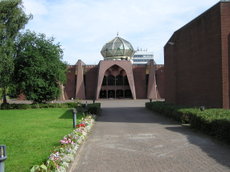
(click to enlarge - The Glasgow Central Mosque in Scotland)
 Mosques gradually diffused to different parts of Europe, but the most rapid growth in the number of mosques has occurred within the past century as more Muslims have migrated to the continent. Major European cities, such as Rome, London, and Munich, are home to mosques that feature traditional domes and minarets. Mosques gradually diffused to different parts of Europe, but the most rapid growth in the number of mosques has occurred within the past century as more Muslims have migrated to the continent. Major European cities, such as Rome, London, and Munich, are home to mosques that feature traditional domes and minarets.
 These large mosques in urban centers are supposed to serve as community and social centers for a large group of Muslims that occupy the region. However, one can still find smaller mosques in more suburban and rural regions throughout Europe where Muslims populate. These large mosques in urban centers are supposed to serve as community and social centers for a large group of Muslims that occupy the region. However, one can still find smaller mosques in more suburban and rural regions throughout Europe where Muslims populate.
 Mosques first appeared in the United States in the early twentieth century, the first of which was built in the late 1920s in Cedar Rapids, Iowa. However, as more immigrants continue to arrive in the country, especially from South Asia, the number of American mosques is increasing faster than ever before. Whereas only two percent of the country's mosques appeared in the United States before 1950, eighty-seven percent of American mosques were founded after 1970 and fifty percent of American mosques founded after 1980. Mosques first appeared in the United States in the early twentieth century, the first of which was built in the late 1920s in Cedar Rapids, Iowa. However, as more immigrants continue to arrive in the country, especially from South Asia, the number of American mosques is increasing faster than ever before. Whereas only two percent of the country's mosques appeared in the United States before 1950, eighty-seven percent of American mosques were founded after 1970 and fifty percent of American mosques founded after 1980.
Conversion of places of worship
 Conversion of non-Muslim houses of worship into mosques began during the life of Muhammad, who turned the pagan sanctuary of Kaaba into a mosque, and continued during subsequent Islamic conquests and under the Muslim rule. As a result, numerous churches, synagogues, Zoroastrian and Hindu temples became Muslim places of worship. Conversion of non-Muslim houses of worship into mosques began during the life of Muhammad, who turned the pagan sanctuary of Kaaba into a mosque, and continued during subsequent Islamic conquests and under the Muslim rule. As a result, numerous churches, synagogues, Zoroastrian and Hindu temples became Muslim places of worship.
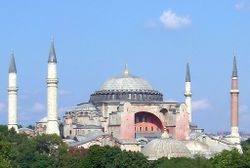
(click to enlarge - Hagia Sophia, an Eastern Orthodox church converted into a mosque on the day of the Fall of Constantinople. Now it is a museum.)
 According to Islamic law, non-Muslims should not continue to use their places of worship for their intended purposes if they are conquered by Muslims and if there exists no treaty of surrender that explicitly mentions the right of non-Muslims to continue to use their places of worship. According to Islamic law, non-Muslims should not continue to use their places of worship for their intended purposes if they are conquered by Muslims and if there exists no treaty of surrender that explicitly mentions the right of non-Muslims to continue to use their places of worship.
 According to early Muslim historians, towns that surrendered without resistance and made treaties with the Muslims received permission to retain their churches and synagogues, while in towns taken by conquest, Jewish and Christian places of worship were seized by the Muslims. According to early Muslim historians, towns that surrendered without resistance and made treaties with the Muslims received permission to retain their churches and synagogues, while in towns taken by conquest, Jewish and Christian places of worship were seized by the Muslims.
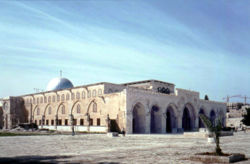
(click to enlarge - Al-Aqsa Mosque (pictured) was built on the Temple Mount, the holiest site in Judaism. It is the third holiest mosque in Islam.)
 One of the earliest examples of these kinds of conversions was in Damascus, Syria, where in 705 Umayyad caliph Abd al-Malik took the church of St. John from the Christians and had it rebuilt as a mosque, which is now known as Umayyad Mosque; overall, Abd al-Malik is said to have transformed 10 churches in Damascus into mosques. One of the earliest examples of these kinds of conversions was in Damascus, Syria, where in 705 Umayyad caliph Abd al-Malik took the church of St. John from the Christians and had it rebuilt as a mosque, which is now known as Umayyad Mosque; overall, Abd al-Malik is said to have transformed 10 churches in Damascus into mosques.
 The process of turning churches into mosques was especially intensive in the villages, with the gradual conversion of the people to Islam. During his persecution of the Copts, Abbasid caliph al-Ma'mun turned many churches into mosques, both in Cairo and in Egyptian villages, which had no mosques in the earlier generations of Islam. Ottoman Turks converted into mosques nearly all churches, monasteries, and chapels in Constantinople, including the famous St. Sophia cathedral, immediately after capturing the city in 1453. The process of turning churches into mosques was especially intensive in the villages, with the gradual conversion of the people to Islam. During his persecution of the Copts, Abbasid caliph al-Ma'mun turned many churches into mosques, both in Cairo and in Egyptian villages, which had no mosques in the earlier generations of Islam. Ottoman Turks converted into mosques nearly all churches, monasteries, and chapels in Constantinople, including the famous St. Sophia cathedral, immediately after capturing the city in 1453.
 In some instances mosques have been established on the places of Jewish or Christian sanctuaries associated with Biblical personalities who were also recognized by Islam. For example, Al-Aqsa Mosque and the Dome of the Rock are built on the Temple Mount, the most sacred site in Judaism. Muslim rulers and war commanders in India destroyed many Hindu temples and built mosques in their stead, seeing their actions as fulfillment of religious duty of asserting Islamic superiority. The same fate awaited many Zoroastrian temples after the Islamic conquest of Persia. In some instances mosques have been established on the places of Jewish or Christian sanctuaries associated with Biblical personalities who were also recognized by Islam. For example, Al-Aqsa Mosque and the Dome of the Rock are built on the Temple Mount, the most sacred site in Judaism. Muslim rulers and war commanders in India destroyed many Hindu temples and built mosques in their stead, seeing their actions as fulfillment of religious duty of asserting Islamic superiority. The same fate awaited many Zoroastrian temples after the Islamic conquest of Persia.
 On the other hand, mosques have also been converted for use by other religions, notably in southern Spain, following the conquest of the Moors in 1492. The Iberian Peninsula, Southeast Europe, and India are other regions in the world where such instances occurred once no longer under Muslim rule. On the other hand, mosques have also been converted for use by other religions, notably in southern Spain, following the conquest of the Moors in 1492. The Iberian Peninsula, Southeast Europe, and India are other regions in the world where such instances occurred once no longer under Muslim rule.



|